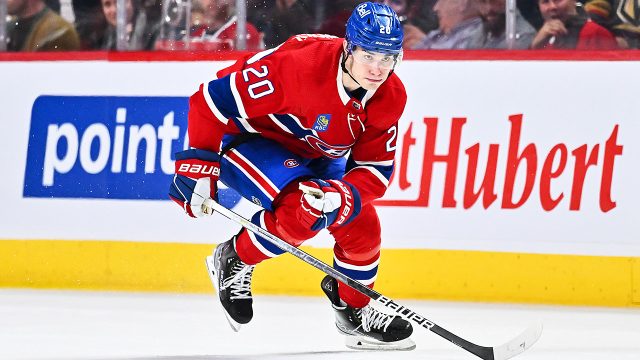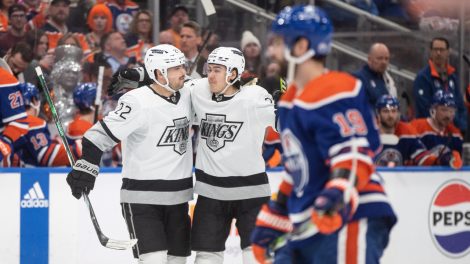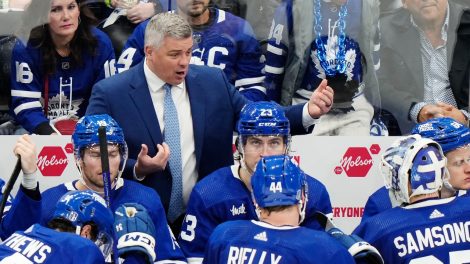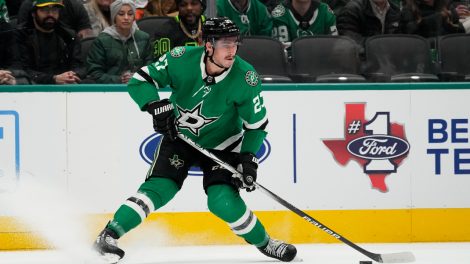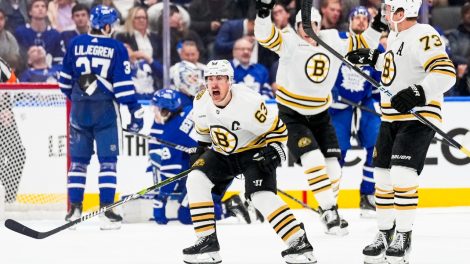BROSSARD, Que. — There’s one thing that’s undeniable when it comes to Juraj Slafkovsky’s development: an injury to his left knee cutting his season down to 39 games certainly isn’t the best thing for it.
The rest remains up for debate, which isn’t likely to cease before Slafkovsky is a fully baked product, years from now.
Whether or not the Canadiens have done right by the kid by starting him in the NHL and keeping him there when he appeared to be struggling will continue to be a subject disputed in these parts, and throughout the hockey world. Wondering if the 18-year-old, who’s collected just four goals and 10 points, would’ve been better served starting—or at least playing some games—in the AHL and joining his Slovakian teammates at the recent world junior championship is going to be something many people continue to do.
But at least general manager Kent Hughes said some things during his 40-minute, mid-season media availability to inform that debate and offer some insight on why the Canadiens have proceeded as they have in the development of the first player they’ve had the privilege of drafting first overall since 1980.
There wasn’t much else to take out of his press conference.
We didn’t expect Hughes to divulge how and where contract negotiations are going with 22-year-old sniper Cole Caufield or to say whether or not he’ll trade Sean Monahan or Joel Edmundson, and he didn’t.
Did Hughes give general answers to questions on those subjects? Sure.
On the first one, he said he wants Caufield to be a Canadien long-term and believes Caufield wants to be one long-term but won’t guarantee an agreement of that nature. And on the second, he said that he’s had conversations with both Monahan and Edmundson—and Josh Anderson, who’s perpetually the subject of trade rumours—to keep them informed of where things stand vis-à-vis their status with the Canadiens and on the trade market.
There was a part where Hughes said he saw Samuel Montembeault as a part of the Canadiens’ future and won’t consider trading the 26-year-old goaltender while his value is rising and he’s only being paid $1 million per season through spring of 2024, and that was a revelatory nugget.
But everything else he said was standard GM speak—the type to be expected a little over halfway through the season and just six weeks ahead of the NHL’s Mar. 3 trade deadline.
Hughes also talked about what he learned in his first year as GM after over two decades spent as an agent, emphasizing the relevance of balance—in roster construction, in development versus results, in building culture versus ensuring premium draft positioning—and that was somewhat interesting.
But what the 52-year-old said about Slafkovsky was most pertinent, especially with the Canadiens’ plan to build a team that can win over a sustained period hinging on the development of its premium and future prospects.
He started by stating that development decisions are made case by case, specific to personalities and abilities, and that there’s no universal way to develop a player. It was a point he reiterated towards the end of his availibility, saying “development comes in many colours.”
Specific to the shades they’ve chosen for Slafkovsky, Hughes ventured into a deep-winded analogy of what it takes to undo certain habits in order to build new ones in a hockey environment, explaining that was the critical first step the Canadiens knew they’d have to embark on with the young Slovak, whose main challenge would be adapting to the North American game after exclusively playing the European one before arriving in Montreal.
Hughes said as a longtime agent he’d often address a client’s concern over the development of their child’s skating by explaining he could point out the deficiencies and offer corrections, but that real change would only come incrementally and over time. That’s because, once you consider the other variables hockey throws at you on a given shift, you’ll be naturally inclined to rely more on what you’ve always done rather than what you’ve learned through correction. He brought it up to say that’s the prism Slafkovsky’s development should be viewed through.
“I (could) watch the way you walk and think your right foot protrudes out and your left foot is in, and if I give you 10 strides (to correct it), you can probably focus on it and do it,” Hughes said. “And if I gave you three balls and asked you to juggle the three balls but want you to walk the way I asked you to walk and make those changes, it becomes more complicated. And if you think of it in the context of hockey, it’s like putting you on a highway, saying, I want you to walk the way I want you to walk, juggle the three balls and don’t get hit by a car. Eventually, you just go to muscle memory…”
Hughes said they’re working with Slafkovsky “to help him understand how he can be most successful in North America,” and explained that it was a step-by-step process to alter his muscle memory. He said that, over this first step, there’s been zero emphasis placed on the player’s production as a measure of his success.
“When we speak of Slaf, he needs to learn how to define his game,” Hughes said. “He has natural talent, and everyone sees it. He’s physically special, too. He’s so strong. For him, there are certain aspects of the game he needs to understand and add so he can become the best player possible.”
When we asked him what about Slafkovsky’s makeup, his personality and his reactions in games made the Canadiens want to continue asking him to walk and juggle three balls while trying to avoid getting hit by cars on the Autobahn of the NHL versus the Decarie Expressway of the AHL, he said, “a couple of things.”
“I mentioned people come with a certain self-confidence…,” Hughes started. “Juraj’s shown us an enthusiasm, a self-confidence—not an arrogance, a self-confidence—and a willingness to learn. I think we’ve seen it in moments when he makes a mistake, I think I saw it in Arizona, I saw it a little bit in our home game against the Rangers, where he makes a mistake and we see it affects him, but it never affected him the next game.”
The other reasons Hughes kept Slafkovsky in Montreal were that he wanted to keep close tabs on him and wanted coach Martin St. Louis and director of development Adam Nicholas to oversee this critical stage of his development versus sending him to the AHL, where the emphasis would be more on scoring.
“We talk weekly to bi-monthly about ‘what do we do here and when is the next step,’ and we had talked about: ‘Are we at that point now where we’re confident with the elements of his game that we’ve been asking him to work on? Where we wanted that consistent reinforcement and feedback that he was getting around here?’” Hughes said.
“We had our eyes on him every day, too. Again, that was a big part of my background as an agent, but I started coaching in college… That’s my passion and background, too, so I wanted to be able to have eyes on him and be able to watch and judge and see that progress…”
Not that the Canadiens weren’t considering sending Slafkovsky down at some point in the near future.
“When we feel like we’ve gotten him to a certain point in Stage 1 of that development, could we have envisioned putting him in the American Hockey League and saying, OK, go play 10 games,” Hughes asked. “But the flipside of it, and concern, was it’s not about offensive production. If we put him in the American Hockey League and then all of the sudden the coaching staff and everyone is expecting him to score and he’s expecting it of himself, then it could be counterproductive.”
Hughes was balancing that reality, and the concern, with wanting to give Slafkovsky the best environment possible to retrain his muscle memory.
“Whether we’re right or wrong, I don’t know, because there is no one path,” he said. “We’re going to go by trial and error as we go through all of this, but we’re coming with a certain background and it’s probably a strength of ours as an organization from management to coaching.”
We’ll find out if that’s accurate over the coming years.
It has to be if the Canadiens are going to get to where Hughes wants to take them.
One thing we can say for sure on this day, though, is that knee injury Slafkovsky suffered in a 2-1 win over the Rangers in New York on Sunday is anything but good for his development.



